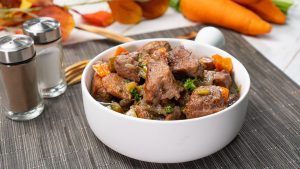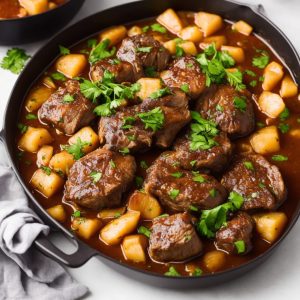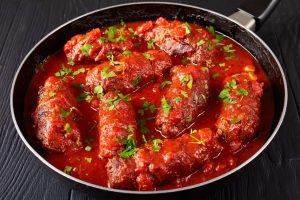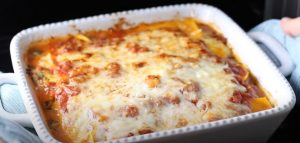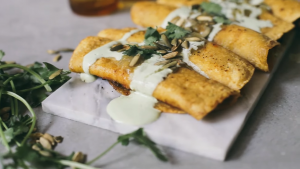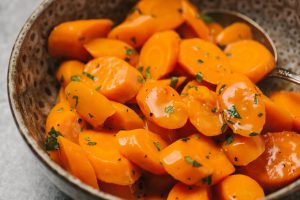Indulge in the rich, savory flavors of tender pork loin roast, braised to perfection and complemented by the sweet popping taste of grapes and the subtle bite of pearl onions. This recipe is perfect for those looking for an elegant yet comforting dish that's sure to impress.
Photos of Braised Pork with Pearl Onions and Grapes Recipe
Key ingredients in this recipe are the boneless rib end pork loin roast, pearl onions, and the mix of red and green grapes. While the pork loin roast is a common cut of meat, the pearl onions and mixed grapes may not be readily available in your pantry. These small, sweet onions and the combination of red and green grapes are essential to achieving the right balance of flavors. So, when you're heading to the supermarket, make sure to look for these ingredients specifically.
Ingredients for Braised Pork with Pearl Onions and Grapes
Pork loin roast: The star of this dish, it's tender, flavorful, and absorbs the flavors of the braising liquid well.
Salt and Pepper: Basic seasonings to enhance the natural flavor of the pork.
Unsalted butter: Adds a rich, creamy flavor to the dish.
Dry white wine: Deglazes the pan, and provides acidity to the dish.
Low sodium chicken broth: Serves as the braising liquid that infuses the pork with flavor.
Garlic: Adds a pungent, spicy flavor.
Bay leaf and Thyme: Herbs that add depth to the flavor profile.
Yellow onion: Adds a sweet, caramelized flavor when cooked.
Pearl onions: Sweet, small onions that hold their shape during cooking.
All purpose flour: It thickens the sauce.
Red and Green grapes: They provide a sweet and slightly tart flavor contrast.
One reader, Karyn Winters says:





The braised pork with pearl onions and grapes recipe is a delightful combination of flavors. The tender pork, sweet grapes, and savory onions create a perfect harmony. The sauce is rich and delicious, and the dish is a definite crowd-pleaser. It's a must-try for anyone who loves a comforting and flavorful meal.
Techniques Required
How to braise the pork: Braising is a cooking method that involves browning the meat and then simmering it in a covered pot with a small amount of liquid. This technique helps to tenderize the pork and infuse it with flavor.
How to brown the pork: Browning the pork in a hot pan with butter helps to develop rich, caramelized flavors on the surface of the meat, adding depth to the dish.
How to make a roux: Creating a roux involves blending softened butter with flour to form a paste. This paste is then used to thicken the cooking liquid and create a velvety sauce.
How to peel pearl onions: After boiling the pearl onions, they need to be peeled. To do this, allow them to cool slightly, then trim off the root end and gently squeeze the onion to release it from its skin.
How to cook the grapes: Cooking the grapes in a skillet over moderate heat until the skins start to burst helps to release their natural sweetness and adds a burst of flavor to the dish.
How To Make Braised Pork with Pearl Onions and Grapes
Sink your teeth into these tender and buttery braised pork dish, served with a side of pearl onions and grapes, for a sweet-juicy compliment to hearty meat.
Serves:
Ingredients
- 1rib end pork loin roast,boneless
- salt and freshly ground pepper
- 5tbspunsalted butter
- ½cupdry white wine
- 2cupchicken broth,low sodium
- 2garlic cloves
- 1bay leaf
- 1thyme sprig,plus 1 tsp of chopped thyme
- ½small yellow onion,coarsely chopped
- ¾lbpearl onions
- 2tbspall purpose flour
- ½lbred and green grapes
Instructions
-
Season the pork with salt and pepper.
-
In a small enameled cast-iron casserole, melt 2 tablespoons of the butter. Add the pork and brown well over moderately high heat for 10 minutes. Transfer to a plate.
-
Pour off the fat from the casserole. Add the wine and boil over high heat for 3 minutes, scraping up the browned bits, until reduced by half.
-
Add the broth and bring to a boil. Add the garlic, bay leaf, thyme sprig, yellow onion and the pork.
-
Cover and simmer over very low heat, for about 1 hour, turning once, until an instant-read thermometer inserted in the center registers 160 degrees F.
-
In a medium saucepan of water, boil the pearl onions for 5 minutes until almost tender. Drain and peel.
-
In a bowl, blend the 2 tablespoons of softened butter with the flour to form a paste. Transfer the pork to a plate.
-
Strain the cooking liquid and return to the casserole, then boil for 4 minutes, until reduced to 2 cups.
-
Whisk ½ cup of the cooking liquid into the flour paste until smooth, then whisk the mixture into the cooking liquid. Simmer over moderately high heat, whisking, until thickened.
-
Simmer over low heat for 5 minutes, stirring, until no floury taste remains. Stir in the chopped thyme and season with salt and pepper.
-
Return the pork and its juices to the casserole and add the pearl onions. Cover and bring just to a simmer, turning the pork a few times in the sauce to heat it up.
-
In a skillet, melt the remaining 1 tablespoon of butter. Add the grapes and cook over moderately high heat, shaking the skillet, until the skins start to burst.
-
Thickly slice the pork and transfer to plates. Spoon the sauce, pearl onions and grapes on top.
-
Serve and enjoy!
Nutrition
- Calories: 349.47kcal
- Fat: 19.81g
- Saturated Fat: 10.88g
- Trans Fat: 0.58g
- Monounsaturated Fat: 6.10g
- Polyunsaturated Fat: 1.27g
- Carbohydrates: 28.48g
- Fiber: 2.65g
- Sugar: 14.98g
- Protein: 11.07g
- Cholesterol: 60.19mg
- Sodium: 823.83mg
- Calcium: 55.69mg
- Potassium: 530.27mg
- Iron: 1.48mg
- Vitamin A: 127.43µg
- Vitamin C: 10.91mg
Technique Tip for Braising Pork with Pearl Onions and Grapes
When browning your pork, make sure to do so over moderately high heat as the recipe suggests. This is crucial for developing a rich, savory flavor in the dish. The browning process, also known as the Maillard reaction, occurs when the proteins and sugars in the meat react under high heat, resulting in a complex flavor profile. Avoid overcrowding the pan, as this can cause the meat to steam rather than brown. If necessary, brown the pork in batches to ensure each piece has enough room.
Time-Saving Tips for Preparing This Dish
Prep ahead: Marinate the pork the night before to enhance the flavor and save time on the day of cooking.
Use a pressure cooker: Speed up the cooking process by using a pressure cooker to braise the pork in a fraction of the time.
Pre-peeled onions: Save time by purchasing pre-peeled pearl onions to skip the peeling step and streamline the cooking process.
One-pot cooking: Consider using a slow cooker for this recipe to simplify the cooking process and minimize cleanup.
Frozen grapes: Use frozen grapes instead of fresh ones to save time on washing, stemming, and halving the grapes.
Substitute Ingredients For Braised Pork with Pearl Onions and Grapes Recipe
boneless rib end pork loin roast - Substitute with boneless pork shoulder: The pork shoulder has a similar fat content and marbling, making it a great substitute for the pork loin roast in braised dishes.
unsalted butter - Substitute with olive oil: Olive oil can be used as a healthier alternative to butter for braising and adds a unique flavor to the dish.
dry white wine - Substitute with chicken or vegetable broth: Broth can be used as a non-alcoholic substitute for white wine in braising, providing depth of flavor without the alcohol content.
low sodium chicken broth - Substitute with vegetable broth: Vegetable broth can be used as an alternative to chicken broth, providing a lighter flavor profile while still adding richness to the dish.
yellow onion - Substitute with white onion: White onions can be used as a substitute for yellow onions, providing a slightly milder flavor while still adding aromatic depth to the dish.
pearl onions - Substitute with shallots: Shallots can be used as a substitute for pearl onions, adding a delicate and sweet flavor to the dish.
red and green grapes - Substitute with dried apricots and prunes: Dried apricots and prunes can be used as a substitute for grapes, adding a sweet and tangy flavor to the braised pork dish.
Presentation Tips for Braised Pork with Pearl Onions and Grapes
Elevate the pork slices: Carefully arrange the sliced pork on the plate, ensuring they are stacked neatly and artistically.
Garnish with pearl onions and grapes: Place the peeled pearl onions and burst grapes around the pork slices, creating a visually appealing arrangement.
Drizzle with reduction sauce: Using a spoon, elegantly drizzle the rich reduction sauce over the pork and around the plate, ensuring it is evenly distributed.
Sprinkle with fresh thyme leaves: Lightly sprinkle the dish with fresh thyme leaves to add a pop of color and a hint of herbal aroma.
Add a touch of edible flowers: Place a few edible flowers strategically around the plate to add a delicate and sophisticated touch to the presentation.
Use a minimalistic approach: Embrace a minimalistic plating style, allowing the natural colors and textures of the dish to shine through.
Incorporate negative space: Utilize negative space on the plate to create a balanced and visually striking presentation, allowing the dish to be the focal point.
Essential Kitchen Tools for Making This Recipe
Cast-iron casserole: A heavy-duty pot with excellent heat retention, perfect for braising and slow cooking dishes.
Instant-read thermometer: Essential for checking the internal temperature of the pork to ensure it is cooked to perfection.
Saucepan: Used for boiling the pearl onions and preparing the butter-flour paste for thickening the sauce.
Skillet: Ideal for cooking the grapes until their skins start to burst, adding a burst of flavor and texture to the dish.
How To Store and Freeze Leftovers
Let the braised pork cool completely to room temperature before storing or freezing. This will help prevent condensation from forming and maintain the quality of the dish.
For short-term storage, transfer the cooled pork, pearl onions, and grapes to an airtight container. Pour the sauce over the top, ensuring that the pork is well-coated. Cover the container tightly with a lid or plastic wrap and refrigerate for up to 3-4 days.
When ready to reheat, transfer the contents of the container to a saucepan or casserole dish. Heat gently over medium-low heat, stirring occasionally, until the pork is warmed through and the sauce is bubbling. Add a splash of chicken broth or water if the sauce seems too thick.
For longer storage, you can freeze the braised pork for up to 2-3 months:
- Divide the cooled pork, pearl onions, grapes, and sauce into portion-sized freezer-safe containers or resealable bags.
- If using containers, leave about 1/2 inch of headspace at the top to allow for expansion during freezing.
- Label the containers or bags with the date and contents, then place them in the freezer.
To reheat frozen braised pork:
- Thaw the frozen pork overnight in the refrigerator.
- Transfer the thawed contents to a saucepan or casserole dish.
- Heat gently over medium-low heat, stirring occasionally, until the pork is warmed through and the sauce is bubbling. You may need to add a little chicken broth or water to thin the sauce if it seems too thick.
Note: The texture of the grapes may change slightly after freezing and thawing, but the overall flavor of the dish should remain delicious.
How To Reheat Leftovers
Reheat the braised pork in a covered dish in the oven at 325°F (165°C) for about 20-25 minutes, or until heated through. This method helps to retain the moisture and prevent the meat from drying out.
For a quicker option, place the pork, pearl onions, and grapes in a microwave-safe dish with a splash of chicken broth or water. Cover the dish with a microwave-safe lid or plastic wrap (leaving a small vent for steam to escape) and microwave on high for 2-3 minutes, stirring occasionally, until heated through.
If you have leftover sauce, reheat it separately in a saucepan over low heat, stirring occasionally. Once the sauce is heated, pour it over the reheated pork, onions, and grapes.
To maintain the texture of the grapes, add them to the dish only during the last few minutes of reheating, or even after the pork and onions have been reheated.
If the sauce appears too thick after reheating, thin it out with a small amount of chicken broth or water until it reaches the desired consistency.
For a crispy exterior, after reheating the pork, place it under the broiler for a couple of minutes, watching carefully to prevent burning.
Random Fact about Braised Pork with Pearl Onions and Grapes
Braised pork with pearl onions and grapes is a classic French dish that combines the savory flavors of pork with the sweetness of grapes and the earthiness of onions. It's a perfect example of the balance of flavors in French cuisine, where sweet and savory elements are often combined in unexpected ways.
Is This Recipe Economical for Home Cooking?
The cost-effectiveness of this braised pork with pearl onions and grapes recipe is moderate. The use of a boneless rib end pork loin roast and a moderate amount of butter and wine may make it slightly more expensive for a household. However, the dish's rich flavors and the use of affordable ingredients like pearl onions and grapes make it a worthwhile investment for a special occasion. On a scale of 1-10, I would rate this recipe a solid 8 for its taste and presentation. The approximate cost for a household of 4 people would be around $40-$50.
Is This Dish Healthy or Unhealthy?
The braised pork with pearl onions and grapes recipe is a delicious and comforting dish, but it may not be the healthiest option due to a few factors:
- The recipe uses a significant amount of butter, which is high in saturated fat. Consuming too much saturated fat can increase the risk of heart disease and other health issues.
- The pork loin, while a lean cut, is still relatively high in fat compared to other protein sources like chicken or fish.
- The recipe calls for a considerable amount of added salt, which can contribute to high blood pressure and other health concerns when consumed in excess.
However, the dish also includes some healthy ingredients, such as onions and grapes, which provide essential vitamins, minerals, and antioxidants.
To make this recipe healthier, consider the following suggestions:
- Reduce the amount of butter used in the recipe, or replace some of it with healthier cooking oils like olive oil or avocado oil.
- Trim any visible fat from the pork loin to reduce the overall fat content of the dish.
- Use low-sodium chicken broth and be mindful of the amount of added salt to help control sodium intake.
- Increase the proportion of vegetables in the recipe, such as adding more onions or incorporating other nutrient-dense vegetables like carrots or celery.
- Serve the braised pork with a side of steamed or roasted vegetables and a whole grain like quinoa or brown rice to create a more balanced meal.
- Use a leaner cut of pork, such as pork tenderloin, to further reduce the fat content of the dish.
Editor's Thoughts on This Braised Pork Recipe
This braised pork with pearl onions and grapes recipe is a delightful combination of savory and sweet flavors. The pork is tender and succulent, and the addition of the pearl onions and grapes adds a wonderful depth of flavor. The cooking method ensures that the pork is cooked to perfection, and the sauce is rich and velvety. The use of white wine and chicken broth creates a delicious base for the dish, and the burst grapes add a pop of freshness. Overall, this recipe is a sophisticated and elegant dish that would impress any dinner guest.
Enhance Your Braised Pork with Pearl Onions and Grapes Recipe with These Unique Side Dishes:
Similar Recipes to Try
Appetizer and Dessert Pairings for Braised Pork
Why trust this Braised Pork with Pearl Onions and Grapes Recipe:
This recipe offers a delightful combination of flavors and textures, creating a harmonious dish that is sure to impress. The succulent pork loin is braised to perfection, infusing it with rich, savory notes. The addition of pearl onions and grapes provides a delightful contrast, adding a touch of sweetness and complexity to the dish. The use of dry white wine and chicken broth enhances the depth of flavor, while the aromatic blend of garlic and thyme infuses the dish with a tantalizing aroma. Trust in this recipe to deliver a memorable dining experience that will leave your taste buds craving for more.
Was this page helpful?
Have your own special recipe to share? Submit Your Recipe Today!
